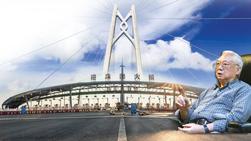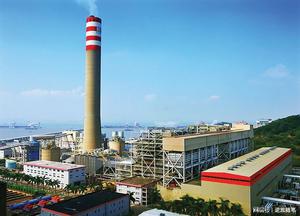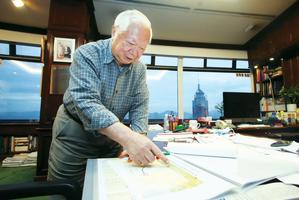Legendary builder Gordon Wu Ying-sheung was among the first Hong Kong tycoons to recognize Shenzhen’s potential. Now he says it’s time to let it lead the way forward. Willa Wu reports from Hong Kong.
 A checkpoint of Hong Kong-Zhuhai-Macao Bridge. Property tycoon Gordon Wu Ying-sheung proposed the idea of the bridge for the first time in 1983. (PHOTO PROVIDED TO CHINA DAILY)
A checkpoint of Hong Kong-Zhuhai-Macao Bridge. Property tycoon Gordon Wu Ying-sheung proposed the idea of the bridge for the first time in 1983. (PHOTO PROVIDED TO CHINA DAILY)
When Gordon Wu Ying-sheung proposed building a superhighway to connect Shenzhen and Guangzhou in 1981, the infrastructure and property tycoon thought it would take the quiet fishing town next to Hong Kong 100 years to become a modern metropolis.
On Oct 14, the 84-year-old was recognized — for having recognized early that his assessment need not be so. Attending a celebration to mark the 40th anniversary of the establishment of the Shenzhen Special Economic Zone, Wu was the only Hong Kong property developer among 40 people honored for their contributions to the 40 years of development that have pushed Shenzhen to fifth among Asian cities in terms of GDP.
“I think the honor shows that I had not failed Shenzhen,” Wu said during an interview in the boardroom on the top floor of his 64-story Hopewell Holdings headquarters in Wan Chai. When Hopewell Centre was completed in 1980, it was the city’s tallest — and first round — building.
Bridges, tunnels, roads
Wu was among the first wave of Hong Kong investors to plough money into the Chinese mainland after then-paramount leader Deng Xiaoping ushered in the reform and opening-up policy in 1978.
Don’t just follow a trend after learning others are making money of it. Do what you are good at. Excel in it so that nobody can catch up with you
Gordon Wu Ying-sheung, chairman of Hopewell Holdings Ltd
Wu took a different approach from his fellow businessmen. Instead of putting money in manufacturing, he set his eyes on bridges, tunnels and roads.
Wu described his business interests as a reflection of his “pragmatic” character.
“I never touched things I didn’t know,” said Wu, who earned his bachelor’s degree in civil engineering from Princeton University in 1958.
Wu recalled telling Liang Xiang, then-Shenzhen’s Party secretary, that a city requires three types of hardware to thrive: transportation, electricity and communication. Knowing nothing of communication, he would provide the other two for Shenzhen. A pragmatic man, as he puts it.
The business icon’s investments in Shenzhen include the Guangshen Expressway, the Chinese mainland’s first expressway built with overseas investment. It directly connects Guangzhou with Shenzhen and Hong Kong at the Huanggang Port.
The project started from Wu’s unpleasant experience in traveling from Guangzhou to Shenzhen. The 150-kilometer distance took him six to seven hours in the early 1980s.
“Bridges, tunnels and roads bring efficiency, a key factor for any city’s development,” he said.
The mainland began accelerating highway construction in 1978, with capital not only from the central government, but also private corporations, banks and overseas investors. At that time, the total road network on the entire land mass of 9.6 million square kilometers was only 890,000 km.
 Gordon Wu (fifth from left) poses with Guangdoing province officials at the groundbreaking ceremony for the Guangshen Expressway on April 23, 1987. (PHOTO PROVIDED TO CHINA DAILY)
Gordon Wu (fifth from left) poses with Guangdoing province officials at the groundbreaking ceremony for the Guangshen Expressway on April 23, 1987. (PHOTO PROVIDED TO CHINA DAILY)
The country entered its highway era when Hujia Expressway, which links Shanghai with its satellite city Jiading, opened to traffic in 1988. One year later, Guangdong province saw its first highway, Guangfo Expressway. Both were financed by local governments.
Wu’s 1981 proposal for the Guangzhou-to-Shenzhen highway took six years to get started. He used that time designing, conducting field surveys, getting approval from different levels of leadership and managing capital.
“I wanted it to commence service as soon as possible,” Wu said. “It would play an important role in the country’s development.”
On July 1, 1997 — the day Hong Kong returned to the motherland, the Guangshen Expressway opened for traffic. Shortening travel time to no more than two hours, the highway links two of the mainland’s four first-tier cities and has a daily traffic volume of around 600,000 vehicles.
Along with the expressway project, Wu was involved in building the Shajiao B Power Station in Dongguan city neighboring Shenzhen, which solved Shenzhen’s lack of a sufficient supply of electricity.
Shenzhen was among in the first batch of cities designated in 1980 as special economic zones, which were granted greater latitude in creating policies attractive to overseas investors as part of the nation’s economic reform. Shenzhen’s official data shows that the city’s urban development has grown from three sq km in 1979 to 940 sq km today, as a permanent population of over 13 million.
When asked about the reasons for Shenzhen’s success, Wu said the city was built on the policy the municipal government has consistently adhered to: reform and opening-up.
“Few governments around the world are able to consistently adhere to the same policy for 40 years, and always encourage entrepreneurship,” Wu said, adding that the consistency in policy helped craft a stable environment for development.
He also praised the people of Shenzhen for their determination to pursue social mobility. “The city leaves an impression on me that people are eager for advancement. It is hard for such a city not to succeed,” Wu concluded.
Shenzhen’s GDP expanded at an annual rate of 20.7 percent to 2.7 trillion yuan (US$403.5 billion) in 2019 from 270 million yuan in 1980.
In 2018, Shenzhen’s GDP surpassed Hong Kong’s for the first time. The special economic zone recorded 2.42 trillion yuan compared to Hong Kong’s HK$2.8 trillion (US$367 billion), equivalent to 2.4 trillion yuan at that year’s exchange rate.
 Shajiao B Power Station in Dongguan city, which was designed by a team led by Gordon Wu. (PHOTO PROVIDED TO CHINA DAILY)
Shajiao B Power Station in Dongguan city, which was designed by a team led by Gordon Wu. (PHOTO PROVIDED TO CHINA DAILY)
HK should prepare for challenges
The celebration Wu attended also marks a new beginning for Shenzhen.
President Xi Jinping, in his speech at the event, urged Shenzhen to promote the development of the Guangdong-Hong Kong-Macao Greater Bay Area, as the city plays a crucial role as a growth engine for the 11-city cluster.
The Bay Area, a national-level development blueprint that ties Hong Kong and Macao with nine mainland cities, is the largest economic zone development in the world. It strives to rival Silicon Valley in the United States.
Ahead of the ceremony, the central government showered Shenzhen with a package of favorable policies, ranging from boosting innovation-driven economy to luring professional talent.
In Wu’s eyes, the engine role Shenzhen is going to play is sending a message to Hong Kong: Prepare for challenges.
Challenges Hong Kong is facing are not just from Shenzhen. Sandwiched between China-US trade tensions and caught by the COVID-19 pandemic, Hong Kong’s GDP shrank by 8.9 percent in the first quarter of 2020 and 9 percent in the second.
But the veteran businessman is optimistic for his home city. He said that Hong Kong is capable of meeting challenges if it can fix two problems: the city’s governing style and acute housing needs.
“The leadership of Hong Kong should be more proactive and fearless. Don’t avoid the pressing affairs in their charge,” he said.
He referred to the city’s longstanding, deep-seated problem — affordable housing. “I noticed that Shenzhen’s rapid development is in part because the government has solved the housing problem, even though a large number of people from rural areas were heading to the city at that time,” he said.
 An aerial view of the Guangshen Expressway. Gordon Wu was one of the investors in the expressway. (PHOTO PROVIDED TO CHINA DAILY)
An aerial view of the Guangshen Expressway. Gordon Wu was one of the investors in the expressway. (PHOTO PROVIDED TO CHINA DAILY)
Wu also attributed part of the violent turbulence Hong Kong experienced in the latter part of 2019 to insufficient affordable housing for the city’s youth. Starting in June 2019, protests against a proposed extradition law amendment, which was ultimately shelved, morphed into violent clashes between radicals and police.
“How can you ask people to work for the city’s development if they are not sheltered in a proper place?” he said. Hong Kong has ranked as the world’s least affordable housing market for 10 consecutive years, according to the annual Demographia International Housing Affordability Study.
Wu backs the government’s proposed Lantau Tomorrow Vision reclamation project, announced by Chief Executive Carrie Lam Cheng Yuet-ngor in her 2018 Policy Address, which is intended to house 1.1 million Hong Kong residents by 2035. The Legislative Council has yet to approve funding for the project’s preliminary study.
But he thumbed his nose at a proposal to ask the central government to lease Zhuhai’s Guishan island to Hong Kong for housing. “Hong Kong can solve the problem itself. Asking the mainland for more land is like begging when having a gold bowl at hand,” Wu said.
Meanwhile, Wu said Hong Kong should change its mindset as the leading force in Southern China. “When Shenzhen started to open its door to overseas investment, Hong Kong was like a big brother to it, helping it a lot. Now it is time for Hong Kong to accept that the leading role could be shouldered by different cities, and cooperation is the only way to consolidate your advantages,” Wu said.
He implored Hong Kong to stay vigilant in maintaining its edge — professional services such as finance and legal, and provide them to Shenzhen in the development of innovation.
“Don’t just follow a trend after learning others are making money of it,” Wu said. “Do what you are good at. Excel in it so that nobody can catch up with you.”
 Gordon Wu points to a map of the Guangzhou-Shenzhen-Zhuhai Expressway on Oct 23 in his Hopewell office. (PARKER ZHENG / CHINA DAILY)
Gordon Wu points to a map of the Guangzhou-Shenzhen-Zhuhai Expressway on Oct 23 in his Hopewell office. (PARKER ZHENG / CHINA DAILY)
Messages to the young
When asked if his success could be copied and pasted by today’s Hong Kong youth, Wu said it sure can.
“As long as they care to look for opportunities in the Bay Area, and be more tolerant when facing a different culture,” he said.
He recalled when Hopewell Holdings invested in building infrastructure on the mainland, some mocked him for building roads on soil where people could not afford bicycles. Now, Wu stands 41st of Hong Kong’s 50 richest persons in 2020, according to Forbes.
“There is a population of 1.4 billion behind the Bay Area. That is a vast market that generates capital and is in great need of talent. And most importantly, it is much easier to reach your own country than foreign ones,” Wu said.
Another message Wu wants to convey to the young: Learn Chinese history, especially what has taken place since the mainland introduced reform and opening-up.
“The history of modern the mainland will help Hong Kong youth to learn how the country shapes its economy and how that promises a bright economic prospect,” Wu said, adding that he believes more youth will be willing to build their future in the Bay Area.
Chinese history is an independent compulsory subject in Hong Kong’s junior high schools, with a newly revised curriculum, which was applied in 2019, that includes a focus on the establishment of the People’s Republic of China and the reform and opening-up that started in 1978 .
But the subject is elective in senior high schools. Data from the Hong Kong Examinations and Assessment Authority shows that from 2011 to 2016, the number of senior students taking Chinese history for their Diploma of Secondary Education exams declined by 70 percent.
“Consider the past, and you shall know the future. I really hope more Hong Kong young people take a look at contemporary Chinese history,” Wu said.
In a corner of Wu’s office stands a desk for sketching architectural drawings. On it are some new sketches, pencils and T-square rulers. At the age of 84, Wu arrives at the office around 9 am every work day. He said he has no specific time for real retirement.
Contact the writer at willa@chinadailyhk.com


